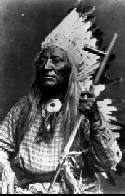

Chief Washakie (c. 1798 – February 20, 1900) was a renowned warrior first mentioned in 1840 in the written record of the American fur trapper, Osborne Russell. In 1851, at the urging of trapper Jim Bridger, Washakie led a band of Shoshones to the council meetings of the Treaty of Fort Laramie (1851). Essentially from that time until his death, he was considered the head of the Eastern Shoshones by the representatives of the United States government.
The
year of his birth is debated. A missionary in 1883 recorded the year of
his birth as 1798, and later his tombstone was inscribed with the date
1804. Late in his life he told an agent at the Shoshone Agency that he
had met Jim Bridger when he was 16. Interpolating from the age of
Bridger when he first went into the wilderness, researchers have
determined that Washakie was likely born between 1808 and 1810. During
his early childhood, the Blackfeet Indians attacked a combined camp of
Flathead and Lemhi people while the latter were on a buffalo hunt near
the Three Forks area of Montana (where the Gallatin, Madison, and
Jefferson rivers form the headwaters of the Missouri River). Washakie's
father was killed; his mother and at least one sister were able to make
their way back to the Lemhis on the Salmon River in Idaho. In the melee
of the attack, Washakie was lost and possibly wounded. According to
some family traditions, he was found by either a band of Bannock
Indians who had also come to hunt in the region, or by a combined
Shoshone and Bannock band. He may have become the adopted son of the
band leader, but for the next two-and-one-half decades (c. 1815-1840)
he learned the traditions and the ways of a warrior that were typical
of any Shoshone youth of that period.
Much about Washakie's early life remains unknown, although several family traditions suggest similar origins. Washakie was born in 1798 to his mother Lost Woman, who was a Tussawehee (White Knife) Shoshoni by birth, and his father, Crooked Leg (Paseego), an Umatilla rescued as a boy from slave traders at Wakemap and Celilo in 1786 by Weasel Lungs, a Tussawehee dog soldier (White Knife) Shoshoni medicine man. Washakie's father, Crooked Leg, was adopted into Weasel Lungs' clan. There, Crooked Leg, would become a Tussawehee dog soldier (White Knife) Shoshoni, as he would meet and marry Weasel Lungs' eldest daughter Lost Girl, later Lost Woman. Thus, Washakie's maternal grandfather was Weasel Lungs. His maternal grandmother, Chosro (Bluebird)), was also Tussawehee by birth. Lost Woman's younger sister, Washakie's aunt was Nanawu (Little Striped Squirrel), the mother of Chochoco (Has No Horse), who was therefore a first cousin to Washakie. tu sert a rien le kikou
His
prowess in battle, his efforts for peace, and his commitment to his
people's welfare made him one of the most respected leaders in Native
American history. In 1878 a U.S. army outpost located on the
reservation was renamed Fort Washakie, which was the only U.S military
outpost to be named after a Native American. Upon his death in 1900, he
became the only known Native American to be given a full military
funeral.[4]
Washakie County, Wyoming was named for him. In 2000, the state of
Wyoming donated a bronze statue of Washakie to the National Statuary
Hall Collection. There is also a statue of Chief Washakie in downtown
Casper, Wyoming. The dining hall at the University of Wyoming is also
named after him. The current ghost town of Washakie, Utah was also
named after him.
During
World War II, a 422-foot (129 m) Liberty Ship built in Portland,
Oregon, in 1942, SS Chief Washakie, was named in his honor. USS
Washakie, a United States Navy harbor tug in service from 1944 to 1946
and from 1953 to 1975, also was named for him.[11]
Washakie was a hide painter. An epic 1880 painted elk hide at the
Glenbow-Alberta Institute is attributed to him. The hide painting
portrays the Sun Dance.[
"The white man, who possesses this whole vast country from sea to sea, who roams over it at pleasure and lives where he likes, cannot know the cramp we feel in this little spot, with the underlying remembrance of the fact, which you know as well as we, that every foot of what you proudly call America not very long ago belonged to the red man. The Great Spirit gave it to us. There was room for all His many tribes, and all were happy in their freedom."
"The white man's government promised that if we, the Shoshones, would be content with the little patch allowed us, it would keep us well supplied with everything necessary to comfortable living, and would see that no white man should cross our borders for our game or anything that is ours. But it has not kept its word! The white man kills our game, captures our furs, and sometimes feeds his herds upon our meadows. And your great and mighty government--oh sir, I hesitate, for I cannot tell the half! It does not protect our rights. It leaves us without the promised seed, without tools for cultivating the land, without implements for harvesting our crops, without breeding animals better than ours, without the food we still lack, after all we can do, without the many comforts we cannot produce, without the schools we so much need for our children."
"I say again, the government does not keep its word!"
![]() Return to
Indigenous Peoples' Literature
Return to
Indigenous Peoples' Literature
Compiled by: Glenn Welker
This site has been accessed over 10,000,000 times since February 8,
1996.